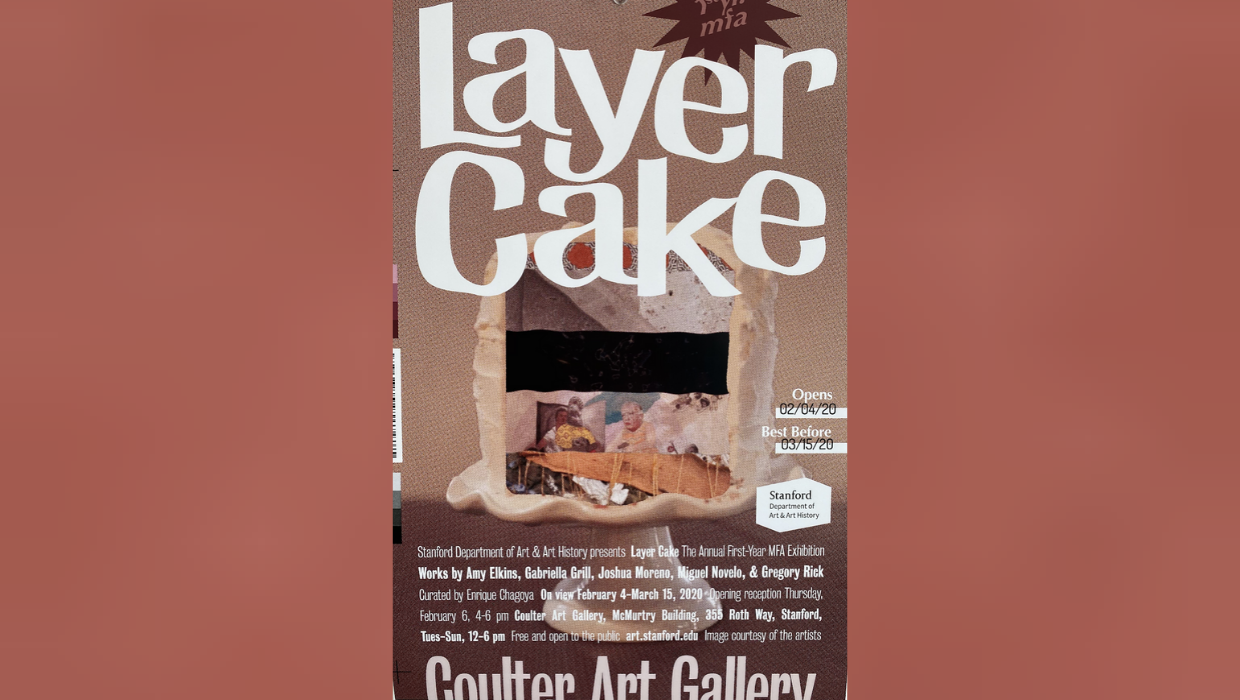“Layer Cake” is a thought-provoking and engaging exhibition featuring works by five talented MFA students in multiple media. The diverse sculpture, installation, digital art, drawing and painting artworks are presented in McMurtry’s Coulter Art Gallery. These artists draw their unique content from personal and societal issues, from mass incarceration to man vs. nature. Their “highly engaging productions,” as described by art practice professor Enrique Chagoya, all struck me differently and challenged the way I look at art of different media. I interpret the exhibition’s title as emphasizing the layers of meaning within each artist’s work, but also the distinct differences between each artist that together make a fascinating whole.
Amy Elkins’ 8’ x 18’ installation, the size of a standard US prison cell, features physical prison uniforms and patterns made out of images of them, which mesmerized me with their illusionistic quality. The moving animations of these patterns are displayed on Clear Tech televisions, which are a type of electronic allowed in prisons because of their inspectability. She also includes a tapestry that reads “Anxious Awareness,” which is also composed of small images of uniforms, weaving the theme of mass incarceration through every piece of her work. Staring at this artwork is dizzying, like an experience in prison can be.
Gabriella Grill focuses on the discarded: Seat cushions, glass, milk, chains, silicone and fabric are some of the materials found in her work. Each of her pieces is unique in its quality, and at first look, I didn’t realize that they were all made by the same artist. She pieces multiple discarded materials together into new objects, suspended in time. These works evoke a sense of ghostliness and echoes from the past, even though we don’t know the origins of their materials.
Joshua Moreno exhibits a mixed media installation and graphite abstraction to discuss tensions between the natural and man-made environment. These works are non-concrete but redolent, especially with a close look. Moreno’s graphite drawing is created with spontaneity, with circular and eraser marks making up four quadrants. His installation “Way Things Are” fills the Coulter Art Gallery’s closet, with intricate elements of architecture, found objects and sculpture intentionally arranged. This was my favorite piece in the exhibition; you have to see it to understand its complexity.
“To see and be seen” is Miguel Novelo’s digital art exploring the relationship between the viewer and the artwork. Displayed on multiple high-tech screens, his works are layered with meaning, touching on the concepts of language, translation, freedom and control. His use of technology allows for more points of view and interactivity, and I thought that his use of the nook tablet was especially clever.
Gregory Rick displays intricately painted and inked accordion books, with themes of religion, war and politics. These tie to his personal experiences in Iraq, with his medium of the book an influence from his father. “Art was a bastion of light” for Rick, clear by the complexity of his work. The up-close viewing that these books lend makes the experience more immersive and engaging.
My overall experience of Layer Cake was dynamic, adjusting my perspective with each work I approached. Exhibitions like this, where I don’t have prior knowledge of the artists’ styles or influences, can be the most interesting ones to view and find meaning from. I admire the deep personal connections that each artist has to their work, which is clear by both their content and meticulous executions.
I urge everyone to bite into Layer Cake, now until March 15.
Contact Maria Metzger at mcmetz ‘at’ stanford.edu.
